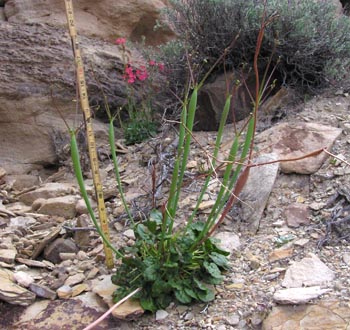Desert Trumpet

Common Name(s):
Desert Trumpet
Native American Pipeweed
Bottlebush
Bottlestopper
Bladder Stem
Indian Pipeweed
Scientific Name:
Eriogonum inflatum Torr. & Frém
Scientific Name Synonyms:
None Known
Symbol:
ERIN4
Description:
Life Span: Annual or Perennial
Origin: Native
Growth Characteristics: Desert Trumpet grows from a woody taproot, and is generally less than 3 feet tall. The swelling is caused by irritation from a moth larva that lives inside the hollow stem. The few stems not infested remain uninflated. It blooms from March to October. The plant dies as soon as the seed is matured. The dried plant remains standing for many months.
Flowers: The small yellow flowers have reddish markings. And occur in a dichotomously branched inflorescence. The flowers are inconspicuous except in high rainfall years, when high amounts of flowers (on many branches) are produced.
Fruits/Seeds: A 3-angeled, winged achene.
Leaves: Basal rosette of leaves, rather inconspicuous. Flat, silvery green, somewhat crinkled.
Stems: The stalk is inflated in the middle, just below the point of branching. Flowering stems are leafless or nearly so, and bear tiny flowers at each node. After flowering, the stems dry out and persist as skeletons for a year or more. Current years stems are a waxy bluish green, last years stems are reddish brown, and older stems are grayish-white.
Ecological Adaptions:
Found in Southern and Eastern Utah, it is common in washes and on mesas, on dry sand or gravel. It prefers dry, well drained slopes.
The winter rains induce leaf production, and summer rain triggers flowering.
Soils: Tolerates alkaline soils. Grows in heavy soil.
Associated Species: Creosote bush, big sagebrush, Joshua tree, pinyon pine, Utah juniper, shadscale, Indian ricegrass, spiny hopsage.
Uses and Management:
The Seri drank a tea of desert trumpet as a cold remedy.
Discovered by Fremont in 1844.

